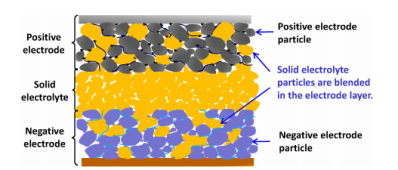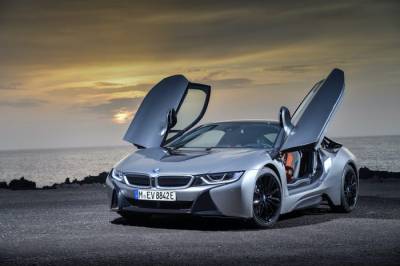Plenty of development is ongoing in the world of lithium batteries for use in electric vehicles. Automakers are scrapping for every little percentage gain to add a few miles of range over their competitors, with efforts to reduce charging times just as frantic as well.
Of course, the real win would be to succeed in bringing a bigger, game-changing battery to market. Solid state batteries fit the bill, potentially offering far greater performance than their traditional lithium counterparts. BMW think there’s merit in the technology, and have announced they intend to show off a solid-state battery vehicle by 2025.
What Makes Solid State Batteries Special?

Solid-state batteries, as their name might suggest, replace liquid electrolytes with solid materials. The hope is that by using a solid electrolyte instead, multiple factors will allow gains in performance that have been impractical to implement with conventional designs. One of the major areas of interest is whether solid state batteries would allow the possibility of using lithium metal anodes, which would provide far higher energy density — 2 to 3 times greater than that of current designs. This would allow for longer range, or simply lighter batteries, than the current status quo. Liquid electrolytes are also behind the high flammability of current lithium batteries. By replacing them with solid compounds of lower flammability, electric cars could be safer. The batteries could also be run at higher temperatures with less risk, reducing the need for cooling, and potentially allowing for higher performance and faster charging times.
However, success with solid-state batteries remains elusive. Hurdles are everywhere, as researchers try to find the magic combination of materials and design that will produce a battery of greater energy density that can hack it in the demanding automotive environment. Current proof-of-concept devices struggle in multiple ways. There are issues with the solid electrolyte changing size over charge and discharge cycles, leading to damage and fracturing, or making poor contact with other battery components, leading to lower performance. Higher numbers on paper aren’t enough; a market-ready solid state battery needs to tick every box, being as or more reliable than its predecessors over timescales of a decade or more.
BMW is Jumping in Just as Fisker Bailed Out
For some, the struggle is too much, with early proponent Fisker recently announcing they’ve abandoned a technology they once hoped to ship in 2018. Other automakers are still in the game however, including VW, who are working with QuantumScape towards a deadline of 2024 — who, incidentally, recently settled a lawsuit with Fisker over the technology. Not to be left out, Toyota are also investing into research as well. There’s clearly four-dimensional chess games going on up and down the industry, which hints at the potential value of success in this area.

BMW are working towards a similar timescale, hoping to have a tech demonstrator out by 2025. If past BMW concepts, or even their electric road cars are anything to go by, expect a swoopy vision of the future, complete with wild and likely impractical styling features. The company expects that the technology won’t be production ready for some time after that, expecting models to ship closer to 2030. This time scale is not uncommon for new automotive technologies. It provides for multiple years for BMW to undertake long-term testing, to determine the performance of the new batteries in all conditions — from Arctic cold to desert heat. Automakers routinely put millions of miles into development mules for even regular vehicles to try and shake down problems; a moonshot battery technology would require just as rigorous attention before launch.
While the announcement is exciting, and a positive sign for the solid-state battery future, it remains likely that we won’t see much in the real world for another 5 to 10 years, if ever. However, if research into solid state batteries does pan out and the technology lives up to the claims, expect them to quickly clear house once production lines get up to speed.
















They can put out a demo by 2025 but if the past is a guide, it’s more likely that solid state batteries will be ready in 2030. It’s a fantastic technology that I’m looking forward to but rushing science is no easy feat.
I think bmw uses this as a advertising, because they are pretty weak in electric would. This way, they are trying to show themselves as inovators…
Weak compared to what? They have more experience in electric vehicles than any other european car company.
its the one eyed among the blind
I can see power-to-liquid technologies coming to the market before they solve the low temperature problem of solid state batteries. Even liquid electrolyte batteries don’t really work below freezing, and it takes a tremendous amount of energy to keep them heated in colder climates.
More efficient drive systems will help by making the most of what’s already there. Lighter and stronger body and structural materials.
They already tried that, and the result was the electric car version of the “MPG gap”, where the actual on-road efficiency was nowhere near the optimized result – or you have to drive like a dildo to achieve it.
Did it vibrate a lot then at speed?
Wasn’t there a South Park feature about it?
The IT!
Did you mean dodo?
Actual market trends veer toward safety improvements and away from weight savings. Lightweight electric vehicles are an oxymoron so why bother?
If they really want solid-state “batteries” they could just lookup graphite “super” capacitors on YouTube.
coat a roll of plastic with graphite and feed it into an old laser printer as an “endless” page,
cut in into half (unless they want 21cm high batteries) and roll it up.
it may not be the highest capacity, but its fast and cheap, and can be replaced with a better battery later.
waiting to 2025 is two years too late..
by then the only limit to Tesla size is the amount of raw nickel they can get ahold of.
or if the their two-tongued CEO ends up in prison, when owning environmental polluting bitcoin becomes a felony.
Do you think BMW will be able to find an old laser printer? They might have to do some dumpster diving behind an old Tandy store.
They’re a pretty big company, I’m sure they have their fingers in as many pies as possible.
Why don’t you go into production and make a few billion selling these things then since it’s so easy and everyone else in the battery game has apparently completely missed this incredible technology?
Don’t be too hasty to judge, they might not have fished out the old laser printer yet. When they’ve got that bad boy up and running they’ll be making rolls of plastic by the bucket load.
But somebody will have to make new drivers for that printer. Windows 98 drivers won’t work anymore. And we all know that it takes more than 2 years to write a new driver. For one, you have to negotiate with all of your partners if they want their logo to be shown in the installer. All your third parties need to have the time to write their own software to include with your driver. You gotta set up a backend to keep track of how everyone is using your driver. Etc. Etc. Etc. Don’t underestimate how much time it costs to write a printer driver!
> lithium metal anodes
> By replacing them with solid compounds of lower flammability, electric cars could be safer
Less safe than say calcium metal anodes. But more safe than sodium metal anodes or even potassium anodes. But as a human (basically a large sack of water, that in a car crash can leak) I would not call it safer.
1:47 to see it self ignite in water – https://www.youtube.com/watch?v=wY0afMI4Jgc
Just been told I’m wrong, that it will not self ignite, but that it will generate a lot of hydrogen gas. So in many ways it is about as petrol in a major car crash.
about> as safe <as
No Hack?
I’d just be happy if BMW stop making the front of the car look like a cartoon beaver.
There was a time when they made classy looking cars, these days they seem to be competing to find the limits of being drunk in charge of a CAD package, and giving an excitable 12-year-old a crate of monster energy and gun that shoots “M” badges.
Then TESLA shares crash.
“four-dimensional chess games going on up and down”, well, a one dimensional chess would do for up and down..
and … not a hack
Everybody wants their car to look like a car. There have been incredibly efficient vehicles that looked like some cartoon version of a toy. There’s no need to have two tons (metric or otherwise) of iron wandering down the road. Loose a ton, efficiency and performance goes up.
“far higher energy density — 2 to 3 times greater than that of current designs”
No matter of the electrolyte being flammable or not, that would come close to the energy density of thermite.
I don’t believe energy densities like this can ever become save to be used in e mobility unless you keep the reaction components separated like in redox flow batteries (or gasoline).